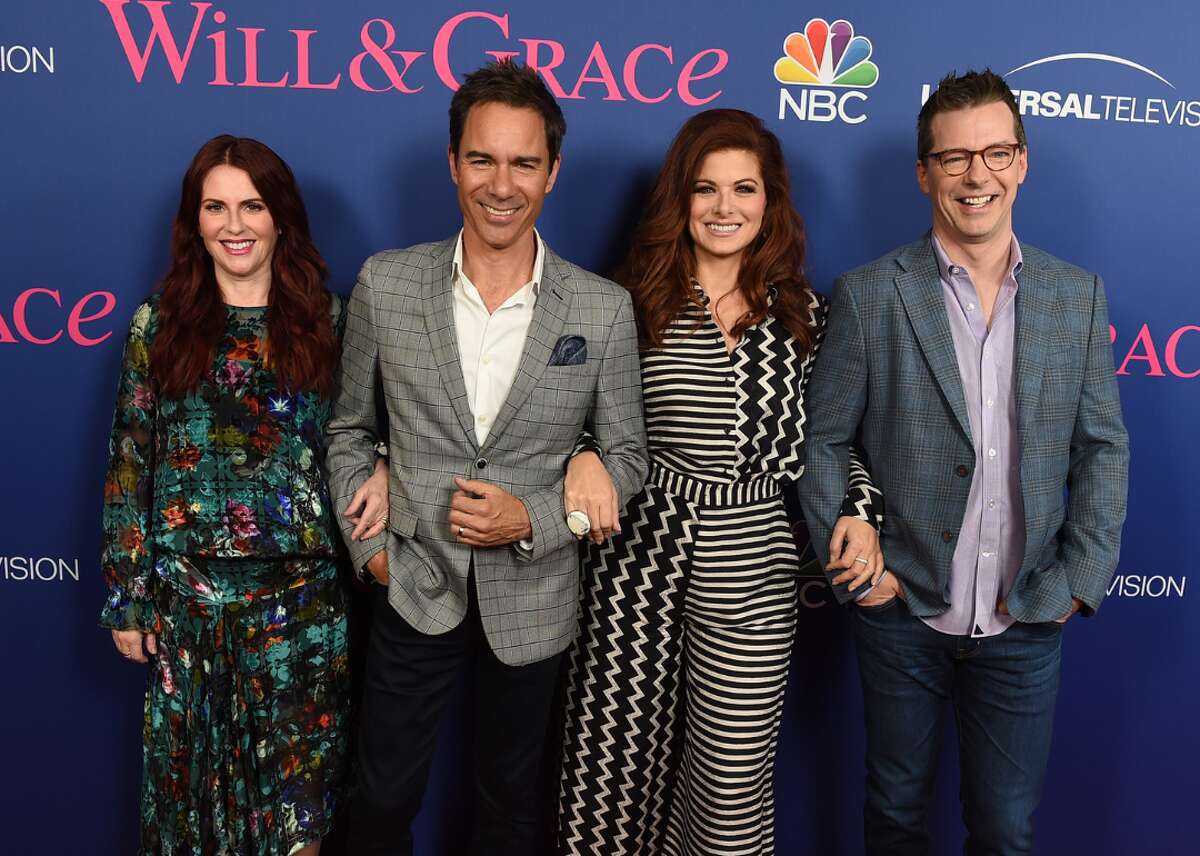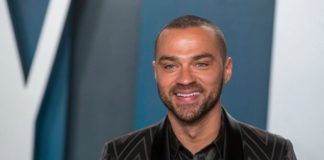Eliza Siegel, Data Work Paris Close, Data Work Luke Hicks, provided by
Oct. 31, 2022
This is a carousel. Use Next and Previous buttons to navigate

Landmark portrayals of LGBTQ+ characters in US sitcom history
Few things feel more quintessentially American than the sitcom. Its features can be recognized anywhere—the laugh track, the unchanging living room or kitchen set that becomes as familiar as one’s own. The traditions that grew out of sitcoms are almost as deeply ingrained: a whole family gathering around the television at a specific time every week, excited to watch a family that looked like theirs finding humor in the mundane.
Sitcoms have long reflected the cultural norms of the time to their viewers, as they were specifically designed to appeal to mass audiences. But occasionally, sitcoms subtly pushed against what was deemed socially acceptable, asking viewers to interrogate their beliefs and preconceptions. By including characters that did not conform to the ideal of a white, heterosexual, middle-class nuclear family, sitcoms started to reshape the very cultural norms they often reinforced.
While sitcoms can be used as a historical record of the cultural values of their time, they also offer insight into what—and who—was not valued. For the first several decades of television history, LGBTQ+ characters did not generally appear. If they did, they were often portrayed as deviant or performative in stereotypical ways and were rarely developed into more than a walking trope. These depictions reinforced the stigma surrounding the LGBTQ+ community and did little to dispel prejudice. But as the gay liberation movement burst forward in the 1970s, catalyzed by events like Stonewall, LGBTQ+ representation on TV began to shift.
The Gay & Lesbian Alliance…
Kevin Winter // Getty ImagesShow MoreShow Less
LGBTQ+ representation on television has jumped dramatically over the last 10 years
There were nearly eight times more LGBTQ+ characters on television in 2021 than in 2010, according to GLAAD data. Despite the production challenges posed by the COVID-19 pandemic in 2020, the number of queer characters more than recovered the following year, surpassing 2019.
The jump in representation is even more significant when considering counts from the early days of GLAAD’s reporting. “There were 12 characters, period, in that first report,” Deerwater said. “It was obviously an immensely different landscape back then.”
Even though 2021 was a record-breaking year regarding the number of queer characters on TV, Deerwater has observed a trend that isn’t so optimistic: shows featuring queer characters and storylines getting greenlit, only to be canceled after one or two seasons. In 2022 alone, queer-led shows including “First Kill,” “Saved by the Bell,” “Queer as Folk,” and “Tom Swift” were canceled after their first or second seasons. “A lot of really inclusive shows are getting canceled as a byproduct of different platforms not putting their weight behind the show, and not giving it a chance to get more views,” Deerwater explained.
StackerShow MoreShow Less
1971: A gay male character appears on ‘All in the Family,’ a first in sitcom history
Two years after Stonewall, the first gay male character to appear on a sitcom—and likely the first gay man many Americans saw represented on television—appeared in an episode of “All in the Family.” The show, created by iconic sitcom showrunner Norman Lear, was about to explode in popularity, becoming the most-watched television program of its time. But the 1971 episode, “Judging Books by Covers,” came early in the first season.
The episode centers on the star of “All in the Family”—the inflammatory Archie Bunker, termed a “lovable bigot” by some critics—whose racist, sexist, and homophobic views were meant to bring attention to social issues through satire. A scene in the episode finds Archie at lunch with his friends and an acquaintance—a well-dressed, well-traveled man named Roger, who Archie openly demeans for appearing to be gay. Later in the episode, Archie goes to the bar and hangs out with his friend Steve, a muscular former football player and bachelor who is clearly set up to be Roger’s visual opposite.
Archie demeans Roger to Steve and challenges Steve to an arm-wrestling match. By the end of the episode, however, the tables have fully turned on Archie—easily beating Archie in the arm wrestle, Steve tells Archie that he, in fact, is gay. When Archie reacts with disbelief and shock, Steve again slams Archie’s arm to the table and…
Tadem ProductionsShow MoreShow Less
1977: A year of firsts on ‘Soap,’ ‘The Jeffersons,’ and ‘Sanford Arms’
1977 was a big year for American culture. Fleetwood Mac released their hit album “Rumours,” Jimmy Carter was sworn in as president after the debacle of the Nixon years and the stumbles of the truncated Ford administration, and “Star Wars Episode IV: A New Hope” was screened in theaters across the country.
Big cultural shifts were also taking place around LGBTQ+ issues. In 1977, Harvey Milk was voted onto the San Francisco Board of Supervisors, making him the first out gay man to hold elected office. Four years earlier, homosexuality was finally declassified as a mental illness and removed from the American Psychiatric Association’s Diagnostic and Statistical Manual. At the same time, only 43% of Americans believed gay or lesbian relations between consenting adults should be legal (compared with 83% in 2019), according to Gallup’s first poll on gay issues.
Changing attitudes about gay rights began trickling into small-screen representation by the late ’70s. On “Soap,” a sitcom that parodied daytime soap operas with melodramatic stories and over-the-top characters, the first gay character to have a main role in a television series was introduced. Jodie Dallas, played by a young Billy Crystal, was a director of television commercials who dated a closeted football player at the start of the series but ended up having several relationships with women. However, he continued to identify as gay throughout the series. Although Jodie’s character does not hold up by today’s standards—particularly his short-lived desire to have sex reassignment surgery to marry…
Embassy TelevisionShow MoreShow Less
1986: The first lesbian character appears on a sitcom in ‘The Golden Girls’
In the second season of “The Golden Girls,” Dorothy’s old friend Jean visits in an episode called “Isn’t It Romantic?” Before she arrives, Dorothy describes her to her mother, Sophia, as a lesbian whose longtime partner recently passed away. She does not tell the rest of her friends, however, for fear that they won’t be accepting of her friend. Throughout the episode, Jean falls for Rose. Lois Nettleton, who played Jean, was nominated for an Emmy for her performance, and Terry Hughes won an Emmy for directing the episode.
This landmark portrayal of a lesbian character was important for more reasons than merely being one of the first of its kind on television. Jean’s character is remarkably well-developed for the time. She is comfortable with her sexuality and is uninterested in hiding it. When she develops feelings for Rose and confesses these feelings, Rose and the other friends treat her with respect, despite not reciprocating the feelings. She is never depicted as predatory or treated as a joke, avoiding common tropes that queer characters of the time frequently fell back on.
The timing of this episode and the type of representation it promoted were significant. Just one year before “Isn’t It Romantic?” aired, Hollywood golden boy Rock Hudson announced that he had AIDS and died shortly after. The AIDS crisis, which began in 1981, produced yet another stigma towards LGBTQ+ Americans and (often negatively) impacted how they were depicted on television and in other media. LGBTQ+ people were dealt another blow in 1986, when the Supreme Court…
Touchstone TelevisionShow MoreShow Less
1991: Sandra Bernhard plays one of the first recurring bisexual characters on television in ‘Roseanne’
Before Roseanne Barr was known for her support for the conspiracy theory “QAnon” and for tweeting a racist attack on former President Barack Obama’s former adviser Valerie Jarrett, her sitcom “Roseanne” was famous for its groundbreaking portrayals of LGBTQ+ characters and topics, as well as its working-class perspective.
In the show’s fourth season, openly bisexual actress Sandra Bernhard played Nancy, a friend of Roseanne’s who came out as a lesbian on the show and later identified as bisexual. As one of the first recurring bisexual characters on television, Bernard’s Nancy broke barriers, dating several women and men throughout the series. Like the rest of the cast, Nancy was small-town and working-class, representing a departure from the urban gay stereotype.
“Roseanne” offered other landmark moments of queer representation as well. Several years before “Will & Grace” paved the way for a gay lead character, “Roseanne” introduced the recurring gay character Leon. In 1995, Leon and his boyfriend, Scott, got married, marking the first same-gender wedding to be shown on television. And in one of the show’s most famous episodes, Nancy brings Roseanne to a gay bar, where one of the first kisses between two women on a sitcom caused so much controversy among network heads at…
Paramount TelevisionShow MoreShow Less
1994: Lesbian parents raise a child and get married for the first time in TV history on ‘Friends’
The quintessentially ’90s sitcom “Friends” introduced the lesbian character Carol and her partner, Susan, early on in the show. The beginning of the series finds Ross recovering from his divorce from Carol, who had come out and left Ross for Susan. Soon after, Carol gives birth to her and Ross’ baby, Ben, whom she co-parents with Susan. Carol and Susan frequently appear throughout the series and eventually get married in the show’s second season.
Carol and Susan’s arc on “Friends” broke barriers in queer television representation in several ways. For one, it was one of the first TV portrayals of same-gender parents raising a child. This was particularly groundbreaking considering, in 1994, only 28% of Americans believed gay and lesbian couples should be legally allowed to adopt children, according to Gallup. Carol and Susan’s wedding, which aired in 1996, was the first lesbian wedding to be shown on television.
Though “Friends” was subversive for depicting queer parenthood and marriage at all, critics have noted in the decades since the show went off the air that these depictions—and the main characters’ attitudes toward queerness—leave a lot to be desired. Carol and Susan’s relationship, and Carol’s lesbian identity, are frequently played for laughs by the straight central cast. Homophobic stereotypes about lesbians are often at the heart of jokes and are frequently used to embarrass or emasculate Ross.
Carol and Susan’s…
Fotos International/Getty ImagesShow MoreShow Less
Gay male characters still account for most LGBTQ+ characters seen on TV
LGBTQ+ characters of most sexual orientations and gender identities have seen an almost consistent increase in representation on television over the last decade. Apart from a dip in 2020 due to COVID-19-related shutdowns, the number of gay, lesbian, bisexual, and trans and nonbinary characters has seen an upward trend.
Some groups have seen faster and greater growth than others, however. Gay male characters still dominate LGBTQ+ representation overall, while transgender and nonbinary characters lag. And some members of the LGBTQ+ community continue to be underrepresented or not represented at all, according to GLAAD’s Deerwater.
“There’s still so many gaps that need to be filled,” she said. “Characters living with HIV, characters with disabilities, people with different body types, and queer Indigenous characters,” as well as queer ensemble casts and multi-season arcs, are all areas where Deerwater says networks and streamers need to push for more.
StackerShow MoreShow Less
1997: Ellen comes out on her sitcom ‘Ellen’—and in real life
In 1997, Ellen DeGeneres made sitcom and television history when her character, Ellen Morgan, came out as a lesbian on her sitcom “Ellen,” making her one of the first main characters on a TV show to do so. Titled “The Puppy Episode” to keep the plot under wraps, the episode featured Ellen falling for another woman, played by Laura Dern, and eventually coming out to her—and an entire airport terminal—when she accidentally says, “I’m gay,” into a hot microphone at the gate.
The same week the episode aired, DeGeneres came out in real life in a Time magazine cover story and on Oprah Winfrey’s talk show (Oprah also made an appearance on “The Puppy Episode” as Ellen’s therapist). The joint coming-out moment became a national sensation: about 44 million viewers tuned into the sitcom episode, triple its regular viewership. Ellen, a mainstream celebrity with a girl-next-door reputation, shattered much of the public’s preconceptions about what a lesbian would look or act like.
There were consequences for DeGeneres’ subversive actions, however. Right-wing public figures like Jerry Falwell and Pat Robertson decried her identity, nicknaming her “Ellen Degenerate.” The “Ellen” production team received hate mail and bomb threats. The show was canceled the season after “The Puppy Episode” aired, following widespread backlash, and both DeGeneres and Dern were blacklisted from working for several years after.
The legacy of “The Puppy Episode” and DeGeneres’ publicly coming out far surpassed the backlash. A 2015 poll found that…
Touchstone TelevisionShow MoreShow Less
1998: The first gay male main character in sitcom history breaks into the mainstream with ‘Will & Grace’
The impact of the popular sitcom “Will & Grace” on LGBTQ+ visibility in mainstream American culture has been well documented. In 2012, then-Vice President Joe Biden famously said he thought the show “probably did more to educate the American public than almost anything anybody’s ever done so far” while voicing his support for gay marriage on NBC’s “Meet the Press.” And in 2014, the Smithsonian National Museum of American History acquired props and scripts from the production of “Will & Grace” for its collection on LGBTQ+ history.
The show centered on two best friends living in New York City: Will, a gay lawyer, and Grace, a straight interior designer. Will’s friend Jack, another gay man, also features as a prominent character. The friends each find love throughout the series and start families of their own.
While the show has been widely credited with endearing the American public to gay characters and shifting mindsets about LGBTQ+ people, many critics have noted the limitations of “Will & Grace.” For one, Will is a white, upper-class, attractive man who rarely discusses his sexuality and exists in a mostly straight world. His character was not representative of many members of the LGBTQ+ community and, to some, seemed specifically designed to be palatable and nonthreatening to straight audiences. Jack, on the other hand, was flamboyant and theater-obsessed. His stereotypical gayness served as the butt…
NBC Inc.Show MoreShow Less
1999-present: LGBTQ+ representation on TV thrives—but not on sitcoms
In 1999, Entertainment Weekly declared the “death of the sitcom” amid the rise of sharper, less predictable dramedies and the diversification of TV formats, which coincided with the introduction of streaming services. While the sitcom did not disappear, the way Americans watched TV, and the kind of TV that became possible, fundamentally shifted during this time, drawing attention away from the traditional sitcom form.
1999 was also the year that began what critics call “The Golden Age of Television.” Starting with “The Sopranos,” television became more cinematic, longer in form, and more serious in tone. Alongside these shifts, and on the heels of shows like “Will & Grace” and “Ellen,” LGBTQ+ characters began appearing more frequently and differently than ever before. “Queer as Folk” premiered in 2000, becoming the first TV show with a gay ensemble cast. In 2003—the same year that the Supreme Court case Lawrence v. Texas finally declared anti-sodomy laws unconstitutional—”Buffy the Vampire Slayer” aired TV’s first lesbian sex scene. “The L Word” premiered a year later, becoming the first television show with a lesbian ensemble cast.
LGBTQ+ characters of color also started appearing on television—after decades of almost entirely white queer representation. “The Wire,” which debuted in 2002, featured what may be the first Black lesbian character on TV: Kima Greggs, a queer Black woman on the Baltimore police force. “The Wire” also introduced other complex queer Black characters, like Omar, a feared…
NetflixShow MoreShow Less
Stacker compiled data from a decade of GLAAD’s “Where We Are on TV” reports and scoured news coverage, critical reviews, and historical documents to investigate the history of LGBTQ+ representation in American sitcoms.









